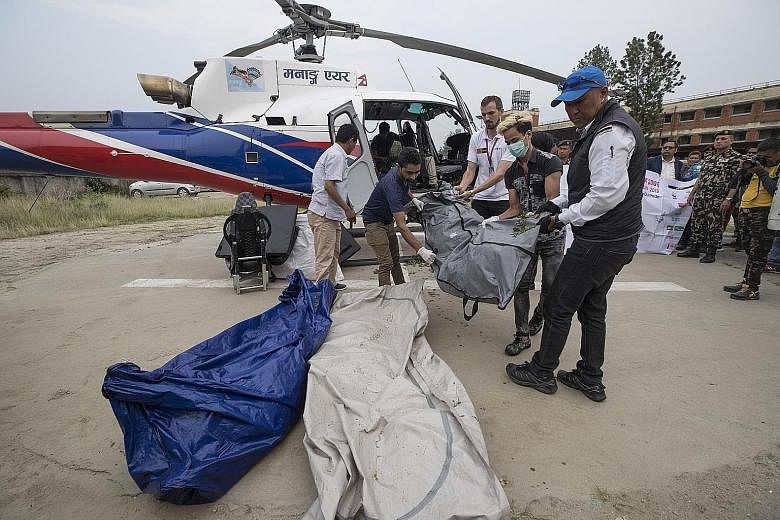KATHMANDU • Indian mountain climber Anjali Kulkarni trained for six years to make it to the top of Mount Everest, the highest peak in the world.
She finally fulfilled her long-time goal when she reached the summit last week. But it was the descent that killed her. Her son Shantanu Kulkarni told CNN that she died after getting stuck in a "traffic jam" on the mountain.
"She had to wait for a long time to reach the summit and descend," Mr Thupden Sherpa, who organised tours on the mountain, told Agence France-Presse (AFP).
"She couldn't move down on her own and died as Sherpa guides brought her down."
Two other Indian climbers, Ms Kalpana Das, 52, and Mr Nihal Bagwan, 27, also died last week.
Mr Keshav Paudel, who organised tours on the mountain, told AFP that Mr Bagwan was "stuck in the traffic for more than 12 hours and was exhausted".
Yesterday, a British climber too weak to descend from Everest died, officials said, bringing the death toll this season on the world's highest peak to 10.
Mr Robin Haynes Fisher, 44, died at 8,700m after returning from the summit, said Mr Murari Sharma of Everest Pariwar Treks in Kathmandu. "He had descended about 150m below the summit when he suddenly collapsed," he said.
-
Role played by weather
-
At least 10 people have died this season on Everest, with several of them killed while waiting to descend from the 8,848m mountain. A few days of clear weather last week saw climbers scrambling to reach the top of the mountain, with the rush contributing to the mounting fatalities.
1. THE RUSH
An estimated 600 people had reached the summit via the Nepal side by last Friday, based on information from expedition organisers, a government official was quoted as saying by Agence France-Presse. Nepal has issued a record 381 permits, costing US$11,000 (S$15,000) each, for mainly foreign climbers for the spring climbing season from late last month to the end of this month. Each climber with a permit is assisted by at least one guide. This adds to the crowd on the mountain. AFP said at least 140 others had been granted permits to scale Everest from the northern flank in Tibet. This means the total number of people reaching the summit could soar past last year's record of 807.
Experienced guides say queues at the summit are not uncommon. "It's normally that crowded," Seven Summit Treks chairman Mingma Sherpa told the BBC.
2. THE WEATHER
The weather plays a big role in contributing to the traffic jam because mountaineers need to avoid fierce jet streams that would hinder them. "If there's one week (of safe weather), then the summit isn't crowded. But sometimes, when there's only a window of two or three days, it gets very crowded," as all the climbers try to reach the summit at the same time, Mr Mingma Sherpa told the BBC.
3. THE HAZARDS
The jam on the mountain can be especially hazardous for climbers. German climber Ralf Dujmovits, who reached the summit in 1992, wrote in an Instagram post that long waits in the bottlenecks of the climbing routes can be deadly for climbers as they may run out of oxygen. Experts say climbers, whose numbers have increased in recent years because expeditions have become more popular, also have to overcome other dangers such as avalanches.
Choo Yun Ting
On Friday, 56-year-old Irishman Kevin Hynes died in his tent at 7,000m after turning back before reaching the summit, UK-based climbing company 360 Expeditions said in a statement.
That same day, Nepalese guide Dhurba Bista, 33, died at base camp after being airlifted from a higher camp following illness.
Earlier this month, a US climber and an Indian climber also died during their descent from Everest.
An Austrian climber died on the Tibetan side of the 8,848m-peak.
Mr Seamus Lawless, an Irish climber who went missing on May 16, is presumed to have died.
Mr Babu Sherpa, managing director of Peak Promotion, said overcrowding had congested the route from Camp IV to the top. "There were only short weather windows and everyone was trying to climb at once," he said.
A chilling photo from the mountain shows a long line of climbers queuing to climb a steep ridge to the peak. Avid mountaineer Nirmal Purja, who took the photo, wrote on Instagram that he estimated there to be 320 people in the line.
Traffic jams create dangerous situations for climbers, who are often already exhausted and carrying heavy loads while battling altitude sickness, which can make people dizzy and nauseated.
Mr Gordan Janow, director of programmes at Alpine Ascents International, has been organising treks to Everest for around 30 years. He said overcrowding often occurs, but "every year seems to be worse and worse".
When a line starts to back up, "you're changing your natural pace so you're spending more time in this high-altitude zone than might be necessary if you were climbing 10 to 15 years ago", he said.
One of the most important skills for the guides who accompany the climbers, he said, "is knowing when to turn people around".
"The idea isn't to push yourself to the ultimate maximum to reach the summit," he said. "Then there's no steam or energy left in your body to get down."
With two or three more days of climbing to come before hostile weather closes the summit again, this season is on target to be one of the most deadly of recent years.
Last year, 807 people reached the mountain's summit - more than had ever reached the top in a single year before. Five climbers died last year.
WASHINGTON POST, DPA

